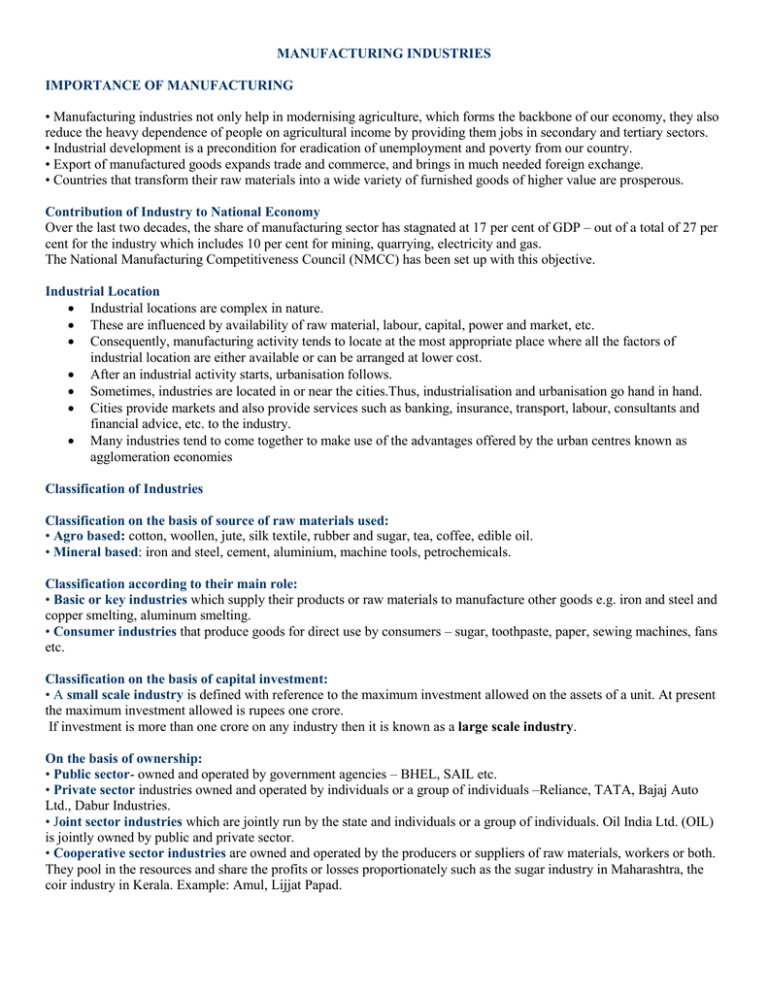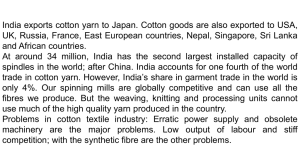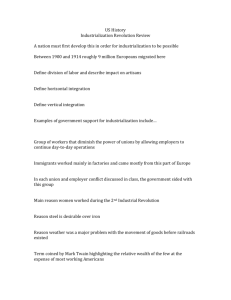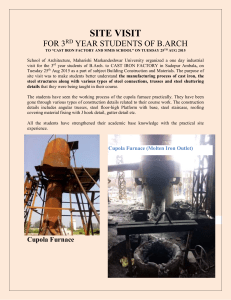MANUFACTURING INDUSTRIES IMPORTANCE OF
advertisement

MANUFACTURING INDUSTRIES IMPORTANCE OF MANUFACTURING • Manufacturing industries not only help in modernising agriculture, which forms the backbone of our economy, they also reduce the heavy dependence of people on agricultural income by providing them jobs in secondary and tertiary sectors. • Industrial development is a precondition for eradication of unemployment and poverty from our country. • Export of manufactured goods expands trade and commerce, and brings in much needed foreign exchange. • Countries that transform their raw materials into a wide variety of furnished goods of higher value are prosperous. Contribution of Industry to National Economy Over the last two decades, the share of manufacturing sector has stagnated at 17 per cent of GDP – out of a total of 27 per cent for the industry which includes 10 per cent for mining, quarrying, electricity and gas. The National Manufacturing Competitiveness Council (NMCC) has been set up with this objective. Industrial Location Industrial locations are complex in nature. These are influenced by availability of raw material, labour, capital, power and market, etc. Consequently, manufacturing activity tends to locate at the most appropriate place where all the factors of industrial location are either available or can be arranged at lower cost. After an industrial activity starts, urbanisation follows. Sometimes, industries are located in or near the cities.Thus, industrialisation and urbanisation go hand in hand. Cities provide markets and also provide services such as banking, insurance, transport, labour, consultants and financial advice, etc. to the industry. Many industries tend to come together to make use of the advantages offered by the urban centres known as agglomeration economies Classification of Industries Classification on the basis of source of raw materials used: • Agro based: cotton, woollen, jute, silk textile, rubber and sugar, tea, coffee, edible oil. • Mineral based: iron and steel, cement, aluminium, machine tools, petrochemicals. Classification according to their main role: • Basic or key industries which supply their products or raw materials to manufacture other goods e.g. iron and steel and copper smelting, aluminum smelting. • Consumer industries that produce goods for direct use by consumers – sugar, toothpaste, paper, sewing machines, fans etc. Classification on the basis of capital investment: • A small scale industry is defined with reference to the maximum investment allowed on the assets of a unit. At present the maximum investment allowed is rupees one crore. If investment is more than one crore on any industry then it is known as a large scale industry. On the basis of ownership: • Public sector- owned and operated by government agencies – BHEL, SAIL etc. • Private sector industries owned and operated by individuals or a group of individuals –Reliance, TATA, Bajaj Auto Ltd., Dabur Industries. • Joint sector industries which are jointly run by the state and individuals or a group of individuals. Oil India Ltd. (OIL) is jointly owned by public and private sector. • Cooperative sector industries are owned and operated by the producers or suppliers of raw materials, workers or both. They pool in the resources and share the profits or losses proportionately such as the sugar industry in Maharashtra, the coir industry in Kerala. Example: Amul, Lijjat Papad. Based on the bulk and weight of raw material and finished goods: • Heavy industries such as iron and steel • Light industries that use light raw materials and produce light goods such as electrical industries. Agro Based Industries Textile Industry: It contributes significantly to industrial production (14 per cent), employment generation (35 million persons directly – the second largest after agriculture) and foreign exchange earnings (about 24.6 per cent). It contributes 4 per cent towards GDP. It is the only industry in the country, which is self reliant and complete in the value chain i.e., from raw material to the highest value added products. History of Cotton Textiles in India: In ancient India, cotton textiles were produced with hand spinning and handloom weaving techniques. After the 18th century, power looms came into use. Our traditional industries suffered a setback during the colonial period because they could not compete with the mill made cloth from England. Today, there are nearly 1600 cotton and human made fibre textile mills in the country. About 80 per cent of these are in the private sector and the rest in the public and cooperative sectors. In the early years, the cotton textile industry was concentrated in the cotton growing belt of Maharashtra and Gujarat. Availability of raw cotton, market, transport including accessible port facilities, labour, moist climate, etc. contributed towards its localisation. This industry has close links with agriculture and provides a living to farmers, cotton boll pluckers and workers engaged in ginning, spinning, weaving, dyeing, designing, packaging, tailoring and sewing. The industry by creating demands supports many other industries, such as, chemicals and dyes, mill stores, packaging materials and engineering works. India exports yarn to Japan. Other importers of cotton goods from India are U.S.A., U.K., Russia, France, East European countries, Nepal, Singapore, Sri Lanka, and African countries. India has the second largest installed capacity of spindles in the world, next to China. We have a large share in the world trade of cotton yarn, accounting for one fourth of the total trade. However, our trade in garments is only 4 per cent of the world’s total. Problems of the Cotton Mills. Our spinning mills are competitive at the global level and capable of using all the fibres we produce. The weaving, knitting and processing units cannot use much of the high quality yarn that is produced in the country. There are some large and modern factories in these segments, but most of the production is in fragmented small units, which cater to the local market. This mismatch is a major drawback for the industry. As a result, many of our spinners export cotton yarn while apparel/garment manufactures have to import fabric . Power supply is erratic Machinery needs to be upgraded in the weaving and processing sectors in particular. Other problems are the low output of labour and stiff competition with the synthetic fibre industry. Jute Textiles India is the largest producer of raw jute and jute goods and stands at second place as an exporter after Bangladesh. Most of the jute mills are located in West Bengal, mainly along the banks of the river Hoogli. The first jute mill was set up near Kolkata in 1859 at Rishra. After Partition in 1947, the jute mills remained in India but three-fourth of the jute producing area went to Bangladesh. Factors responsible for their location in the Hugli basin are: proximity of the jute producing areas, inexpensive water transport, supported by a good network of railways, roadways and waterways to facilitate movement of raw material to the mills, abundant water for processing raw jute, cheap labour from West Bengal and adjoining states of Bihar, Orissa and Uttar Pradesh. Kolkata as a large urban centre provides banking, insurance and port facilities for export of jute goods. The jute industry supports 2.61 lakh workers directly and another 40 lakhs small and marginal farmers who are engaged in cultivation of jute and mesta. Problems 1. Stiff competition in the international market from synthetic substitutes and from other competitors like Bangladesh, Brazil, Philippines, Egypt and Thailand. 2. However, the internal demand has been on the increase due to the Government policy of mandatory use of jute packaging. 3. To stimulate demand, the products need to be diversified. In 2005, National Jute Policy was formulated with the objective of increasing productivity, improving quality, ensuring good prices to the jute farmers and enhancing the yield per hectare. The main markets are U.S.A., Canada, Russia, United Arab Republic, U.K. and Australia. The growing global concern for environment friendly, biodegradable materials, has once again opened the opportunity for jute products. Sugar Industry India stands second as a world producer of sugar but occupies the first place in the production of gur and khandsari. The raw material used in this industry is bulky, and in haulage its sucrose content reduces. There are over 460 sugar mills in the country spread over Uttar Pradesh, Bihar, Maharashtra, Karnataka, Tamil Nadu, Andhra Pradesh and Gujarat along with Punjab, Haryana and Madhya Pradesh. Sixty per cent mills are in Uttar Pradesh and Bihar. This industry is seasonal in nature so, it is ideally suited to the cooperative sector. In recent years, there is a tendency for the mills to shift and concentrate in the southern and western states, especially in Maharashtra, This is because the cane produced here has a higher sucrose content. The cooler climate also ensures a longer crushing season. Moreover, the cooperatives are more successful in these states. Major challenges include: 1. the seasonal nature of the industry, 2. old and inefficient methods of production, 3. transport delay in reaching cane to factories and 4. the need to maximise the use of baggase. Mineral based Industries Iron and Steel Industry The iron and steel Industry is the basic industry since all the other industries — heavy, medium and light, depend on it for their machinery. Steel is needed to manufacture a variety of engineering goods, construction material, defence, medical, telephonic, scientific equipment and a variety of consumer goods. Production and consumption of steel is often regarded as the index of a country’s development. Iron and steel is a heavy industry because all the raw materials as well as finished goods are heavy and bulky entailing heavy transportation costs. Iron ore, coking coal and lime stone are required in the ratio of approximately 4 : 2 : 1. Some quantities of manganese, are also required to harden the steel. India ranks ninth among the world crude steel producers. It is the largest producer of sponge iron. China is the largest producer. China is also the world’s largest consumer of steel Chotanagpur plateau region has the maximum concentration of iron and steel industries. It is largely, because of the relative advantages this region has for the development of this industry. These include, low cost of iron ore, high grade raw materials in proximity, cheap labour and vast growth potential in the home market. Though, India is an important iron and steel producing country in the world yet, we are not able to perform to our full potential largely due to: (a) High costs and limited availability of coking coal (b) Lower productivity of labour (c) Irregular supply of energy and (d) Poor infrastructure. We also import good quality steel from other countries. However, the overall production of steel is sufficient to meet our domestic demand. Liberalisation and Foreign Direct Investment have given a boost to the industry with the efforts of private entrepreneurs. There is a need to allocate resources for research and development to produce steel more computatitively. Aluminium The raw material used in the smelters is a very bulky, dark reddish coloured rock. Regular supply of electricity and an assured source of raw material at minimum cost are the two prime factors for location of the industry. Aluminium Smelting Aluminium smelting is the second most important metallurgical industry in India. It is light, resistant to corrosion, a good conductor of heat, malleable and becomes strong when it is mixed with other metals. It is used to manufacture aircraft, utensils and wires. It has gained popularity as a substitute of steel, copper, zinc and lead in a number of industries. There are 8 aluminium smelting plants in the country located in Orissa (Nalco and Balco), West Bengal, Kerala, Uttar Pradesh, Chattisgarh. Cement Industry Cement is essential for construction activity such as building houses, factories, bridges, roads, airports, dams and for other commercial establishments. This industry requires bulky and heavy raw materials like limestone, silica, alumina and gypsum. Coal and electric power are needed apart from rail transportation. The industry has strategically located plants in Gujarat that have suitable access to the market in the Gulf countries. The first cement plant was set up in Chennai in 1904. After Independence the industry expanded. Decontrol of price and distribution since 1989 and other policy reforms led the cement industry to make rapid strides in capacity, process, technology and production. There are 128 large plants and mini cement plants in the country. India produces a variety of cement. Improvement in the quality has found the produce a readily available market in East Asia, Middle East, Africa and South Asia apart from a large demand within the country. Chemical Industries It contributes approximately 3 per cent of the GDP. It is the third largest in Asia and occupies the twelfth place in the world in term of its size. It comprises both large and small scale manufacturing units. Rapid growth has been recorded in both inorganic and organic sectors. Inorganic chemicals include sulphuric acid (used to manufacture fertilisers, synthetic fibres, plastics, adhesives, paints, dyes stuffs), nitric acid, alkalies, soda ash (used to make glass, soaps and detergents, paper) and caustic soda. Organic chemicals include petrochemicals, which are used for manufacturing of synthetic fibers, synthetic rubber, plastics, dyestuffs, drugs and pharmaceuticals. Organic chemical plants are located near oil refineries or petrochemical plants. The chemical industry is its own largest consumer. Basic chemicals undergo processing to further produce other chemicals that are used for industrial application, agriculture or directly for consumer markets. Fertiliser Industry The fertiliser industry is centred around the production of nitrogenous fertilizers (mainly urea), phosphatic fertilisers and ammonium phosphate (DAP) and complex fertilisers which have a combination of nitrogen (N), phosphate (P), and potash (K). The third, i.e. potash is entirely imported as the country does not have any reserves of commercially usable potash or potassium compounds in any form. India is the third largest producer of nitrogenous fertilisers. There are 57 fertiliser units manufacturing nitrogenous and complex nitrogenous fertilisers, 29 for urea and 9 for producing ammonium sulphate as a byproduct and 68 other small units produce single superphosphate. At present, there are 10 public sector undertakings and one in cooperative sector at Hazira in Gujarat under the Fertiliser Corporation of India. After the Green Revolution the industry expanded to several other parts of the country. Gujarat, Tamil Nadu, Uttar Pradesh, Punjab and Kerala contribute towards half the fertilizer production. Other significant producers are Andhra Pradesh, Orissa, Rajasthan, Bihar, Maharashtra, Assam, West Bengal, Goa, Delhi, Madhya Pradesh and Karnataka. Automobile Industry Automobiles provide vehicle for quick transport of good services and passengers. Trucks, buses, cars, motor cycles, scooters, three wheelers and multi-utility vehicles are manufactured in India at various centres. After the liberalisation, the coming in of new and contemporary models stimulated the demand for vehicles in the market, which led to the healthy growth of the industry including passenger cars, two and three wheelers. Foreign Direct Investment brought in new technology and aligned the industry with global developments. At present, there are 15 manufacturers of passenger cars and multi-utility vehicles, 9 of commercial vehicles, 14 of the two and three wheelers. The industry is located around Delhi, Gurgaon, Mumbai, Pune, Chennai, Kolkata, Lucknow, Indore, Hyderabad, Jamshedpur and Bangalore. Information Technology and Electronics Industry The electronics industry covers a wide range of products from transistor sets to television, telephones, cellular telecom, pagers, telephone exchange, radars, computers and many other equipments required by the telecommunication industry. Bangalore has emerged as the electronic capital of India. Other important centres for electronic goods are Mumbai, Delhi, Hyderabad, Pune, Chennai, Kolkata, Lucknow and Coimbatore. 18 software technology parks provide single window service and high data communication facility to software experts. A major impact of this industry has been on employment generation. It is encouraging to know that 30 per cent of the people employed in this sector are women. This industry has been a major foreign exchange earner in the last two or three years because of its fast growing Business Processes Outsourcing (BPO) sector. Industrial Pollution and Environmental Degradation Although industries contribute significantly to India’s economic growth and development, the increase in pollution of land, water, air, noise and resulting degradation of environment that they have caused, cannot be overlooked. Industries are responsible for four types of pollution: (a) Air (b) Water (c) Land (d) Noise. The polluting industries also include thermal power plants. Air Pollution Air pollution is caused by the presence of high proportion of undesirable gases, such as sulphur dioxide and carbon monoxide. Airborne particulate materials contain both solid and liquid particles like dust, sprays mist and smoke. Smoke is emitted by chemical and paper factories, brick kilns, refineries and smelting plants, and burning of fossil fuels in big and small factories that ignore pollution norms. Toxic gas leaks can be very hazardous with long term effects. Air pollution adversely affects human health, animals, plants, buildings and the atmosphere as a whole. Water Pollution Water pollution is caused by organic and inorganic industrial wastes and affluents discharged into rivers. The main culprits in this regard are paper, pulp, chemical, textile and dyeing, petroleum refineries, tanneries and electroplating industries that let out dyes, detergents, acids, salts and heavy metals like lead and mercury pesticides, fertilisers, synthetic chemicals with carbon, plastics and rubber, etc. into the water bodies. Fly ash, phospo-gypsum and iron and steel slags are the major solid wastes in India. Thermal pollution of water occurs when hot water from factories and thermal plants is drained into rivers and ponds before cooling. Wastes from nuclear power plants, nuclear and weapon production facilities cause cancers, birth defects and miscarriages. Soil and water pollution are closely related. Dumping of wastes specially glass, harmful chemicals, industrial effluents, packaging, salts and garbage renders the soil useless. Rain water percolates to the soil carrying the pollutants to the ground and the ground water also gets contaminated. Noise Pollution Noise pollution not only results in irritation and anger, it can also cause hearing impairment, increased heart rate and blood pressure among other physiological effects. Unwanted sound is an irritant and a source of stress. Industrial and construction activities, machinery, factory equipment, generators, saws and pneumatic and electric drills also make a lot of noise. Control of Environmental Degradation Some suggestions are: (i) minimising use water for processing by reusing and recycling it in two or more successive stages (ii) harvesting of rainwater to meet water requirements (iii) treating hot water and effluents before releasing them in rivers and ponds. Treatment of industrial effluents can be done in three phases (a) Primary treatment by mechanical means. This involves screening, grinding, flocculation and sedimentation. (b) Secondary treatment by biological process (c) Tertiary treatment by biological, chemical and physical processes. This involves recycling of wastewater. Other methods: Overdrawing of ground water reserves by industry where there is a threat to ground water resources also needs to be regulated legally. Particulate matter in the air can be reduced by fitting smoke stacks to factories with electrostatic precipitators, fabric filters, scrubbers and inertial separators. Smoke can be reduced by using oil or gas instead of coal in factories. Machinery and equipment can be used and generators should be fitted with silencers. Almost all machinery can be redesigned to increase energy efficiency and reduce noise. Noise absorbing material may be used apart from personal use of earplugs and earphones. NTPC shows the way NTPC is a major power providing corporation in India. It has ISO certification for EMS (Environment Management System) 14001. The corporation has a proactive approach for preserving the natural environment and resources like water, oil and gas and fuels in places where it is setting up power plants. This has been possible through (a) Optimum utilisation of equipment adopting latest techniques and upgrading existing equipment. (b) Minimising waste generation by maximising ash utilisation. (c) Providing green belts for nurturing ecological balance and addressing the question of special purpose vehicles for afforestation. (d) Reducing environmental pollution through ash pond management, ash water recycling system and liquid waste management. (e) Ecological monitoring, reviews and online database management for all its power stations.





